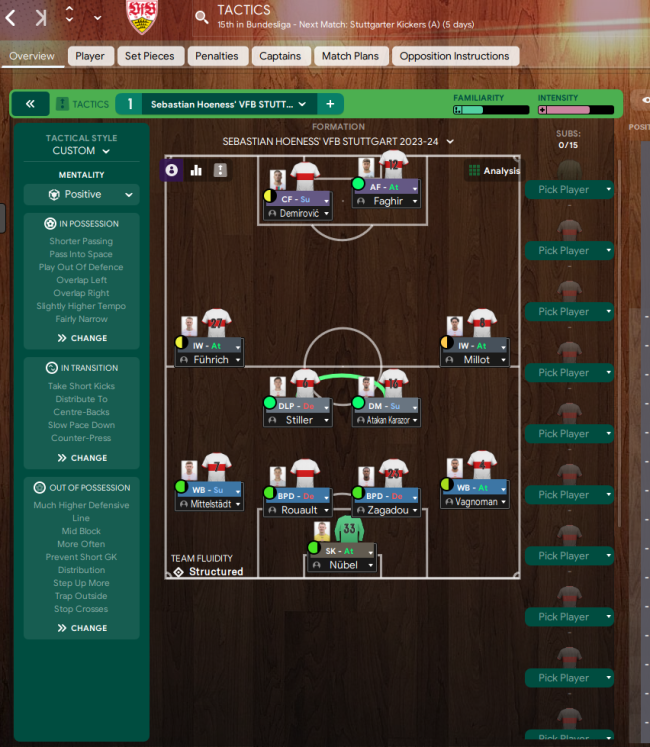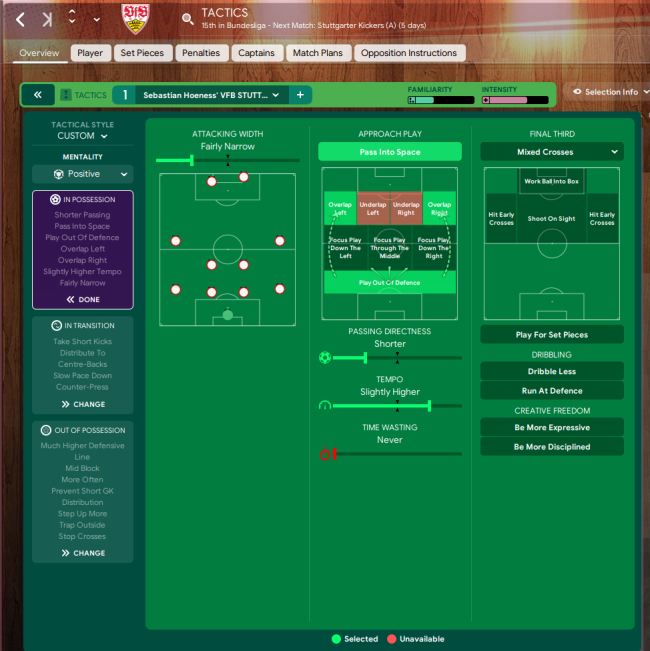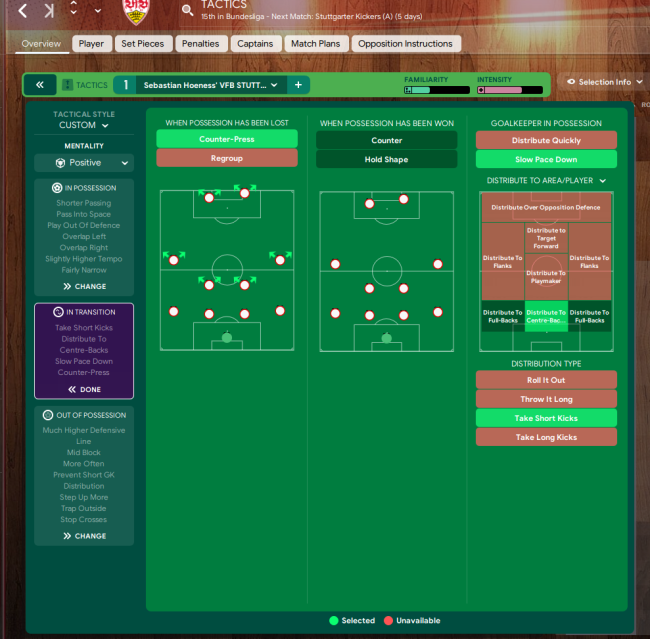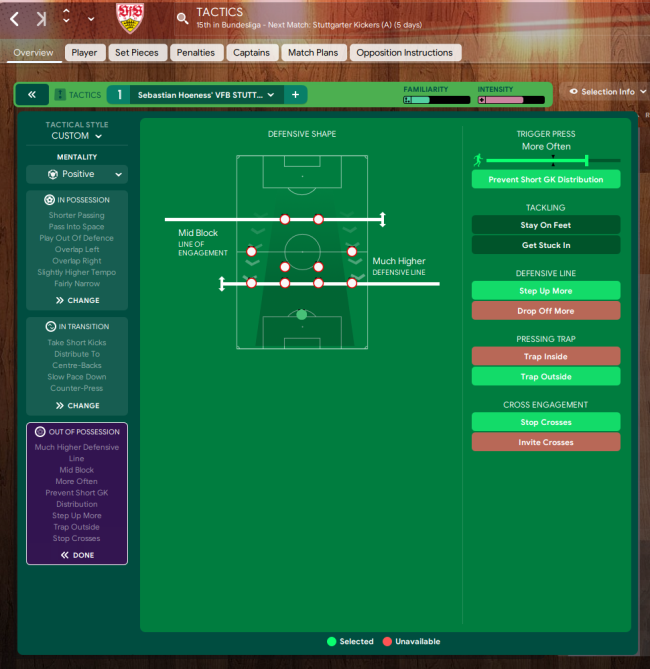| Tester | Team | ME | Win % | PPG | AGF | AGA | GD | PL | W | D | L | |
|---|---|---|---|---|---|---|---|---|---|---|---|---|
| Total | 73% | 2.35 | 2.56 | 0.97 | 1.6 | 121 | 88 | 20 | 13 | |||
| TommyOfTheNorth |
 Real Sociedad
Real Sociedad
|
24.4.0 | 87% | 2.66 | 3.0 | 0.7 | 2.32 | 38 | 33 | 2 | 3 | |
| Deleted User #1866315 |
 Stuttgart
Stuttgart
|
24.3 | 85% | 2.68 | 2.7 | 1.0 | 1.65 | 34 | 29 | 4 | 1 | |
| GBMM |
 Everton
Everton
|
24.4.0 | 58% | 1.97 | 2.3 | 1.1 | 1.24 | 38 | 22 | 9 | 7 | |
| UKTomJN2011 |
 Atlético
Atlético
|
24.4.0 | 36% | 1.55 | 1.5 | 1.3 | 0.18 | 11 | 4 | 5 | 2 | |
Hi guys this is my emulation of Sebastian Hoeness's 4-4-2 VFB Stuttgart season 2023-2024 I won the treble!!
VfB Stuttgart Under Sebastian Hoeneß: Tactical Analysis
Welcome to an in-depth exploration of VfB Stuttgart's tactics under Sebastian Hoeneß. This article dissects the strategic elements that define Hoeneß’s coaching philosophy and their on-field manifestations. We'll cover formations, pressing schemes, and other key components of Stuttgart’s tactical setup, shedding light on the intricacies behind their success. Hoeneß’s influence on the team has been significant, and through this analysis, we aim to uncover the tactical nuances that have driven VfB Stuttgart’s impressive performances. Join us as we decode the tactical blueprint of Sebastian Hoeneß’s Stuttgart.
Formation: 4-4-2 (preferred, but sometimes 3-4-2-1 and 4-2-3-1 are used too)
Build-up Play
Low Build-up
In the low build-up phase, Hoeneß employs a 1-4-2-4 formation. The two forwards position themselves high up the pitch, creating a large gap between the opposition's midfield and defense, which they can exploit by dropping into this space.
This formation, inspired by Roberto De Zerbi, forces the opposition center-backs into tough decisions. If they step up to mark the dropping strikers, space opens up behind them for the wingers to exploit in one-on-one situations. If they stay back, Stuttgart gains numerical superiority in midfield, allowing them to bypass the press effectively.
High Build-up
In the high build-up phase, Stuttgart transitions to a 1-3-2-5 formation, featuring a back three, two holding midfielders, and five players up front. This setup enhances central options and reduces spacing between players, facilitating Hoeneß’s preference for playing through the middle.
This formation also supports effective defensive transitions, with more players available to press immediately upon losing possession. The compact positioning shortens passing distances, which accelerates ball movement and reduces the time available for the opposition to press.
High Backline
Stuttgart maintains a high defensive line during their build-up, which aids in counter-pressing by keeping players closer to the center. This compactness makes it challenging for the opposition to exploit turnovers and helps Stuttgart quickly regain possession.
Formation Adaptability
Stuttgart frequently adjusts their formation during build-up play to confuse opponents and exploit numerical advantages. Against a front three, Hoeneß might drop a holding midfielder into the backline, creating a 4v3 situation favoring Stuttgart. This flexibility allows Stuttgart to progress the ball effectively and overcome the opposition's pressing.
Hoeneß occasionally shifts from their usual 1-3-2-5 formation, at times integrating a center-back into midfield to form a 1-2-3-5 shape or mirroring their low build-up 1-4-2-4 formation in the high build-up phase.
Attacking Strategy
Finding the Pockets
Stuttgart aims to locate their attacking midfielders in open spaces, leveraging their numerical superiority in midfield. This tactic often involves breaking lines with passes from the back or wings, targeting midfielders who can turn and drive at the defense.
Attacking the half spaces
In the final third, Stuttgart excels at exploiting the space between the opposition's center-back and fullback. This is typically achieved through underlaps from midfielders or wide center-backs. The wingers either pass to the underlapping player for a cross or cut inside to combine with attackers or take a shot.
Overlaps
Stuttgart frequently uses overlaps to create 2v1 situations on the wings. If the opposition fullback covers the overlapping run, the winger can cut inside; if the fullback stays central, the overlapping player receives the ball for a crossing opportunity.
Runs in Behind
Stuttgart effectively converts scenarios where attacking midfielders drive at the defense, timing their runs perfectly to exploit spaces left by advancing center-backs. The strikers make well-timed runs into these spaces to receive passes and create scoring opportunities.
Box Overloads
In the final third, Stuttgart often commits four or five players into the box, creating overloads and forcing the defense into difficult decisions, which frequently leaves players unmarked.
Tactical Principles
Rotations and Interchanges
Hoeneß emphasizes fluidity within his system, using rotations and interchanges to disrupt defensive structures. A common tactic is switching positions in the half-space to create space and confuse defenders.
Third-Man Principle
Stuttgart often employs the third-man principle, using an additional player to bypass blocked passing lanes and reach a free player. This tactic is particularly evident in their low build-up, where center-backs use dropping strikers to connect with forward-facing midfielders.
Numerical Advantages
Stuttgart’s high build-up is characterized by creating numerical advantages. Their front five often outnumber a back four, and they exploit this through coordinated movements between wingers and attacking midfielders to open passing lanes and attack the defense.
Defensive Tactics
High Press
Hoeneß values aggressive pressing, with Stuttgart employing intense, man-to-man high pressure. This approach not only disrupts the opposition’s build-up but also creates scoring opportunities from turnovers.
Low Press
In a low press, Stuttgart adopts a 1-5-2-3 formation, setting up a mid-block that closes down central spaces and forces opponents wide. They push up whenever the opponent makes a slow or backward pass, compressing the pitch and reducing the opposition's chances of creating opportunities.
Transitions
Defensive Transitions
Stuttgart’s central positioning and numerical superiority in midfield enhance their defensive transitions, allowing them to quickly regain possession after losing the ball.
Offensive Transitions
Hoeneß’s team counterattacks with high tempo, focusing on exploiting the spaces between the opposition's center-backs and fullbacks. Their central positioning during defense supports rapid involvement of multiple players in counterattacks.
Conclusion
This tactical analysis highlights the strategic brilliance of Sebastian Hoeneß at VfB Stuttgart. By examining formations, player movements, and strategic principles, we've revealed the dynamic and innovative approach that defines Hoeneß’s tenure. His focus on fluidity, pressing, and positional play has transformed Stuttgart into a formidable team. As Hoeneß continues to refine his tactics, Stuttgart fans can look forward to an exciting journey marked by tactical ingenuity and continued success on the field.
HOW TO CREATE THIS TACTIC IN FOOTBALL MANAGER 2024
A 4-4-2 formation can effectively replicate Sebastian Hoeneß's tactics with VfB Stuttgart in Football Manager 2024. Here's how to set it up, focusing on the tactical principles he employs:
Mentality: Positive (it may work also with attacking if you use stronger teams)
in possession
UNSTOPPABLE Pressing MACHINE Scores 3+ Goals Per Game | FM23 Best Tactics
- Fairly narrow attack width: the players stay compact, wider spaces will be occupied by the two wing-backs who overlaps
- Play out of defense: Hoeness likes Stuttgart to patiently build the play, trick the opponent into press them and exploit the spaces
- Overlap left and right: as said, overlaps are frequently used to create 2vs1 situations
- Pass into space: searching for spaces and exploiting them is a key in Stuttgart’s playing style
- Mixed crosses: Stuttgart often relies into crosses and due to the players’ different qualities, mixed crosses are the best choice.
- Shorter passing directness: when the team builds the play from the back, players are very patient and want to maintain possession. If you want to have even more possession control, change to much shorter.
- Slightly higher tempo: Stuttgart does not play with a very high tempo, players decide tempo according to the situation, therefore, I believe slightly higher is a good choice.
In transition
- Counter-press: players apply pressure to win the ball back after losing possession as soon as possible
- Counter: I did not select this option because once Stuttgart players are able to win the ball back, they can choose to launch a counterattack or to wait and build the play patiently according to the situation. Therefore, I let my players decide.
- Slow pace down: once again, Hoeness wants his players to play slowly when they are in their half, and the keeper does it too.
- Distribute to center backs and take short kicks: starting play from the defense
Out of possession
- Mid-block: combined with a much higher defensive line allows our team to stay compact, restricting the spaces between the two lines that could be exploited by the opponent.
- Much higher defensive line: as said above, it helps our team to gain compactness
- Trigger press more often: pressing is very important in Hoeness’s tactics
- Prevent short gk distribution: with two strikers, it becomes much easier to press the GK and force him to play long-balls that can be easily intercepted by our players
- Trap outside: use the touchline as an additional defender and avoid the opponent players to create threats from the center
- Stop crosses: stop the opponent to cross the ball to the center of the box avoiding potential threats
Players roles and instructions
Nubel: sweeper-keeper (attack): inspired by De Zerbi (and we can see it in Farioli’s OG Nice too), the goalkeeper becomes a playmaker, he stays very high, is comfortable with the ball at his feet and can hold the ball as long as he wants until he finds some space. He can pass it to the defenders or even try to play a long ball towards the strikers, bypassing the midfield.
Wing-backs
Vagnoman: wing-back (attack). Stay wider, dribble more, take more risks.
Vagnoman pushes forward more than Mittelstaedt on the other flank, and he rotates his position with the right winger (Millot or whoever plays in that position)
Maximilian Mittelstädt: wing-back-support: dribble more, stay wider.
He pushes forward less than Vagnoman and that’s why I chose the support duty instead of the attack one. The instruction dribble more does not mean that he will try to dribble past every opponent like crazy, but that he will carry the ball forward when he can to exploit spaces. For the same reason, this instruction applies to the right wing-back Vagnoman and the two ball-playing defenders too.
The hardworking left-back has made a significant impact since transferring to VfB Stuttgart from Hertha Berlin last summer. Initially a substitute, Mittelstädt’s offensive prowess and chemistry with Führich led the coaching staff to elevate him to the starting lineup. Recognized as one of the top players in his position, Mittelstädt is defensively strong with his timely tackles and keen anticipation. His accurate crosses consistently challenge opposing defenses, and his eagerness to join the attack and make forward runs adds a dynamic element to Stuttgart’s offense. Like Führich, Mittelstädt's stellar performances have earned him a call-up to the German national team, marking a major milestone in his career.
Central defenders
Zagadou: ball-playing defender (defend): mark tighter, tackle harder, dribble more.
Rouault: ball-playing defender (defend): mark tighter, tackle harder, dribble more.
Both defenders have the only task to stop all opponent attacks because they, along with the DLP are the only players who hold back.
Wingers
Millot: inverted winger-attack: sit narrower, cross more often.
As an inverted winger, he may cut inside to leave space for the right wing-back, he provides crosses and pushes forward in attack
Chris Führich: inverted winger-attack: sit narrower, cross more often, take more risks, roam from position. Führich sits narrower and cut inside exploiting spaces between the lines especially when Stiller drops deep. With roam from position instruction, he will find the best position to cross or to shoot from long distance and posing threats to the opponent defense.
Chris Führich, a graduate of Borussia Dortmund’s youth academy, has become an essential player for VfB Stuttgart in his third Bundesliga season. Boasting seven goals and seven assists, Führich is a key element in the team's attack, which recently earned him a call-up to the German national team. Renowned for his dynamism and off-the-ball acceleration, Führich is a persistent threat to opposing defenses with his incisive runs and dribbling skills. Though he could attract more fouls, his skill in delivering precise crosses enhances Stuttgart’s offensive play, generating numerous scoring chances for his teammates.
Central Midfielders
Karazor: defensive midfielder-support (mark tighter, get further forward): he has both defensive and attacking tasks, he drops deep to help the defense and moves forward to exploit spaces. In this tactic he is a defensive midfielder in support, and he is instructed to mark tighter and get further forward to support attack. Atakan Karazor, the imposing midfielder who stands at 1.91 meters, has become a crucial player for VfB Stuttgart at the age of 27. His defensive skills and aerial superiority are key to the team's double-pivot system. Karazor’s knack for winning aerial duels, thanks to his impressive height and perfect timing, adds strength to Stuttgart’s midfield. His disciplined play minimizes fouls, enhancing his defensive reliability. Though less involved in build-up play, he excels at executing one- or two-touch passes. His role as a defensive shield is vital, providing essential support for the backline and allowing his midfield partner to control the play higher up the field.
Stiller: deep-lying playmaker- defend. He plays as a deep-lying playmaker, he dictates the tempo and in defense he drops deep, allowing Chris Führich to cut inside and exploit the spaces. Partnering effectively with Karazor in the double pivot, Stiller shines in initiating attacks and dismantling opposition defenses with his sharp passing and keen vision. His seamless transitions from defense to offense enhance the fluidity of Stuttgart's midfield. Additionally, his calmness under pressure and skill in delivering accurate passes make him an essential part of the team's strategy.
Strikers
Guirassy: complete forward-support: except tackle harder, the role preset instructions are all what we need. If you have a striker who is better at scoring than at linking the play in your team, you can give him an attack duty instead of support.
Sehrou Guirassy, the prolific striker, has been the standout performer this season, netting an impressive 24 goals in just 22 league matches. The Guinean forward has exceeded expectations, consistently outperforming his expected goals (xG) of 15 (0.74 per 90 minutes). His athleticism and clinical finishing make him a formidable presence in front of goal, frequently delivering crucial moments that have been vital for his team's success. Beyond his scoring ability, Guirassy excels in dribbling and has a talent for drawing fouls, making him a comprehensive attacking threat. Additionally, his knack for providing key passes adds another layer to his game, underscoring his versatility and significance in the team’s offensive strategy.
Deniz Undav: advanced forward-attack: tackle harder, roam from position. He moves a lot and can pose threats from various positions.
Deniz Undav’s remarkable season stands out, with the striker scoring an impressive 14 goals and providing seven assists for VfB Stuttgart. After a challenging period at Brighton, Undav has made a strong comeback, establishing himself as a prolific goal scorer for his new club. His clinical finishing and ability to set up goals make him a formidable attacking force. Additionally, his resilience and determination have been crucial in overcoming setbacks and delivering consistent performances on the pitch. Undav’s resurgence embodies the collective spirit and determination within the VfB Stuttgart squad under Sebastian Hoeneß’s leadership.
Test Results
 Stuttgart
Stuttgart
| ME | Win % | PPG | AGF | AGA | GD | PL | W | D | L | |
|---|---|---|---|---|---|---|---|---|---|---|
| 24.3 | 85% | 2.68 | 2.7 | 1.0 | 1.65 | 34 | 29 | 4 | 1 |
 Real Sociedad
Real Sociedad
| ME | Win % | PPG | AGF | AGA | GD | PL | W | D | L | |
|---|---|---|---|---|---|---|---|---|---|---|
| 24.4.0 | 87% | 2.66 | 3.0 | 0.7 | 2.32 | 38 | 33 | 2 | 3 |
Really fantastic tactic although I think I was very lucky with how bad the other top teams were. I lost a lot of starters in the winter transfer window due to release clauses so had to replace a lot of them which I think cost me our Champions League run (went out in the quarter finals to Arsenal). Brais Mendez on the right flank and Umar Sadiq as the complete forward are absolute monsters so try to sign them up to new contracts early!
Second season is going to be interesting because I can't see RM and Barca underperform like that again!
 Atlético
Atlético
| ME | Win % | PPG | AGF | AGA | GD | PL | W | D | L | |
|---|---|---|---|---|---|---|---|---|---|---|
| 24.4.0 | 36% | 1.55 | 1.5 | 1.3 | 0.18 | 11 | 4 | 5 | 2 |
The Barcelona game was my first game in charge i think this tactic could be good for us after i hopefully rebuild the spine of the team in the summer with some younger fresher legs and someone able to put the ball in the back of the net but we have shown a solid foundation to build on with being hard to beat
 Everton
Everton
| ME | Win % | PPG | AGF | AGA | GD | PL | W | D | L | |
|---|---|---|---|---|---|---|---|---|---|---|
| 24.4.0 | 58% | 1.97 | 2.3 | 1.1 | 1.24 | 38 | 22 | 9 | 7 |
3rd place in PL
Lost in the Carabao Cup final against Man City
2-0 and 2-1 victory against Liverpool
4-0 win against Chelsea
4-3 win against Tottenham
5-0 win against Man United
3-1 win against Man City
Same team until January, because Calvert-Lewin wanted to go. Only change in starting 11 was Dolberg to replace Calvert-Lewin
Comments
You'll need to Login to comment






TommyOfTheNorth
I should add that I flipped the tactic, see picture.
Thank you very much for your comment
You had really great results I am happy that my tactic worked for you and yes, you can flip it according to your players qualities and it still works well. Hope in the next season you will have even better results!